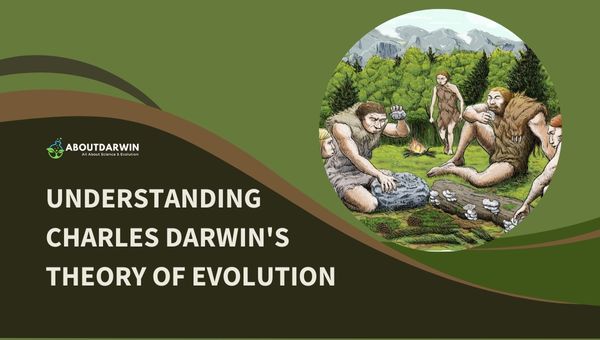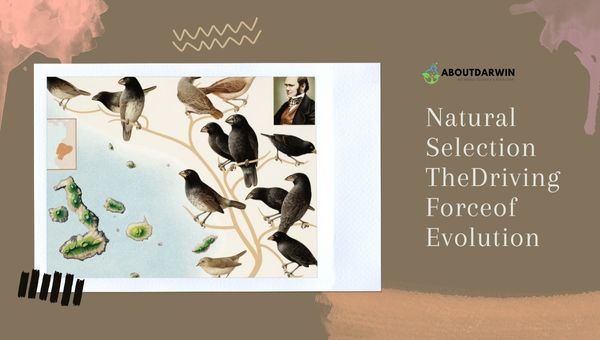Physical Address
304 North Cardinal St.
Dorchester Center, MA 02124
Charles Darwin‘s theory of evolution and the concept of natural selection have fundamentally altered our understanding of life and its ever-changing nature. As a blogger well-versed in the nuances of Darwin’s groundbreaking work, I’ll shed some light on this pivotal theory and its implications for the biological world.
Evolution, at its core, refers to the gradual change in traits within a population over generations. Darwin’s crucial insight was that natural selection drives these changes, shaping species to better adapt to their environments.
Through countless observations and studies, he concluded that the fittest individuals within a population are more likely to survive and pass on their advantageous traits to offspring. This, in turn, leads to the evolution of species over time.
In the following article, I’ll delve deeper into the fascinating intricacies of Darwin’s theory of evolution and examine how natural selection contributes to the diversity of life we observe today.
Contents
When I first delved into Charles Darwin’s theory of evolution, I discovered an elegant explanation for the incredible diversity of life on our planet. At its core, the theory revolves around natural selection, a process governing the traits passed down from generation to generation.

To grasp the concept of natural selection, it’s vital to understand the following key points:
By favoring certain traits over others, natural selection acts as a powerful force that shapes the overall makeup of a population. As generations go by, these advantageous traits become increasingly prevalent, leading to gradual changes in species over time.
It’s worth noting that Darwin’s theory and his publication, On the Origin of Species, were met with controversy when they first emerged in the mid-19th century. Critics challenged the idea that species could change so profoundly through natural processes, arguing for a more static view of the natural world instead.
However, in the years following its publication, a vast array of evidence has emerged to support the theory of evolution. These findings span numerous scientific disciplines, from genetics to paleontology, and are just a few examples:
Through the lens of Darwin’s theory of evolution, the breathtaking diversity and interconnectedness of life emerge as the products of countless generations and the relentless force of natural selection. By adapting to their surroundings, species continually transform and branch off, forming the intricate tapestry of nature we know today.
Natural selection is the key mechanism that drives evolution, helping species adapt to their environments and resist extinction. I’ll discuss this process and its significance in the context of Charles Darwin’s groundbreaking theory of evolution.

To get started, let me explain natural selection in a nutshell. It’s the process in which specific traits – which make certain individuals more adaptable to their environment – become more prevalent within a population over time. We can break this down into three basic principles:
A classic example of natural selection in action is the peppered moth in the UK. Through a series of events, Light and dark-colored moths showed different rates of survival and reproduction:
Apart from this example, there are countless other instances of natural selection at work in various species. A few notable examples include:
Natural selection contributes to speciation, the formation of new and distinct species. When populations face new environmental challenges or become isolated, natural selection favors different traits in each group, leading to the emergence of unique species over time.
In my exploration of Charles Darwin’s theory of evolution, it’s become clear that natural selection is the primary force driving evolutionary change. As a result, understanding this process is crucial for grasping the complexity and diversity of life on Earth.
Ideas About Evolution Before Charles Darwin
Despite its widespread acceptance, the theory of evolution has faced its share of critiques and misunderstandings. In this section, I’ll delve into some common misconceptions about Charles Darwin’s theory of evolution and natural selection.

One common critique is that evolution promotes the survival of the fittest mentality, suggesting that only the strongest and most aggressive individuals will succeed. However, this misunderstanding stems from misinterpreting the term “fittest.” In evolutionary biology, “fitness” refers to an organism’s ability to survive and reproduce, often involving cooperation and symbiotic relationships rather than brute strength or aggression.
Another misunderstanding surrounding evolution is the belief that it’s a purely random process. While genetic mutations occur randomly, natural selection is the non-random process by which organisms with advantageous traits are more likely to survive and reproduce. Consequently, this confusion often leads to the perception that evolution is based solely on chance rather than natural selection’s powerful driving force.
A common argument against evolution is that it contradicts religious beliefs, particularly the belief in a divine creator. However, it’s essential to recognize that the theory of evolution does not negate the existence of a higher power. Evolutionary theory serves to explain the diversity and development of living organisms while remaining neutral on the subject of religion or spirituality.
Additionally, critics of evolution often point to gaps in the fossil record as evidence against the theory. While it’s true that there are incomplete fossil records, we should consider the rarity of fossilization and the vast geological timescales involved. Existing fossils have provided crucial evidence supporting evolution, including discovering numerous transitional forms.
Misconceptions about evolution can also lead to flawed arguments, such as conflating macroevolution and microevolution. Microevolution refers to small-scale changes within a species, while macroevolution deals with the emergence of new species over time.
Critics may argue that microevolution is observable, but macroevolution is not. Nevertheless, given enough time, microevolutionary changes accumulate, leading to the macroevolutionary events evidenced by the fossil record and genetic data.
Addressing these critiques and misunderstandings is vital for comprehensively understanding Charles Darwin’s theory of evolution and natural selection. We can better appreciate this influential theory’s elegance and explanatory power by overcoming these misconceptions.
I’ve noticed that recent advancements in evolutionary biology have contributed significantly to our understanding of the Theory of Evolution. Let’s dive into some key developments that have further clarified Darwin’s theory of natural selection and the mechanisms at work in the evolution of species.
Researchers have recognized that the central dogma of molecular biology has set the groundwork for modern evolutionary theory. This refers to the flow of genetic information from DNA to RNA to protein, which links genetic sequences to phenotypes. It has driven researchers to understand how genetic mutations affect phenotypic traits and an organism’s fitness.
The discovery of epigenetics has added another layer of complexity to evolutionary theory. It refers to changes in gene expression that don’t alter the DNA sequence itself but are still passed down to future generations. This has shown us that the environment can significantly impact an organism’s gene expression, contributing to adaptive changes across generations.
Another fascinating development is the concept of genetic drift. It posits that random variations in gene frequency can occur within a population. This may lead to decreased genetic diversity and even the fixation or loss of a specific allele over time. I can’t stress enough how valuable this addition has been; it has illustrated the importance of considering both selective pressures and random events in population evolution.
In the modern age, we’ve seen a rapid accumulation of genomic data fueled by advancements in DNA sequencing technologies. This wealth of information has provided evolutionary biologists with insights into the genomes of various organisms, enabling them to identify genes and pathways critical to the evolutionary process.
Furthermore, comparative genomics has helped identify similarities and differences in the genomes of related species, revealing shared ancestry and evolutionary relationships.
It would be remiss not to mention the role of computer simulations in unraveling evolutionary processes. These simulations use algorithms that model populations over time, allowing scientists to understand and predict evolutionary outcomes based on different scenarios. Some examples include:
Ultimately, these modern developments have significantly enhanced our understanding of the many factors that shape evolutionary processes. They’ve also highlighted the importance of integrating various disciplines and methodologies to pursue a more comprehensive and holistic understanding of the complex mechanisms underlying evolution.
The Theory of Evolution has had far-reaching impacts on various fields of science and society as a whole. Let’s take a closer look at some of these implications.
First, in biology, it’s undeniable that the theory of evolution has significantly advanced our understanding of the natural world. It has shed light on the origins of species and the mechanisms through which they adapt and diversify over time. Specifically, Darwin’s ideas have:
Another area where the theory of evolution has been influential is in medicine. By recognizing the interconnectedness of life and the fundamental principles that govern biological systems, researchers have made significant progress in:
The implications of the theory of evolution truly extend beyond science, having made a mark on society and culture as well. Perhaps most significantly, it has shifted our understanding of what it means to be human. Key societal implications include:
| Area of Impact | Effect |
|---|---|
| Biology | Advancing knowledge of the natural world |
| Medicine | Improving treatments and understanding of disease |
| Society & Culture | Impacting worldview and ethical considerations |
Despite its far-reaching implications, it’s essential to acknowledge that the theory of evolution remains just that – a theory. While a wealth of evidence supports it and is widely accepted within the scientific community, it’s vital to maintain an open-minded approach in the pursuit of knowledge. After all, scientific understanding continues to evolve, much like the natural world it seeks to explain.
Having explored the theory of evolution, it’s clear that Charles Darwin’s concept of natural selection has profoundly impacted our understanding of the natural world. The theory has withstood the test of time and continues to serve as the foundation for modern biology and genetics.
Through years of observation, Darwin proposed that species change over time and that those traits best suited for survival will be passed on to future generations. This idea was groundbreaking, challenging the prevailing notions of a static and immutable natural world.
Some key points to consider about the theory of evolution and natural selection:
In light of recent advancements in genetics, the veracity of Darwin’s theory has only strengthened. Understanding our genetic makeup has allowed us to comprehend further how traits change over generations, providing substantial support to the theory of natural selection.
Despite being proposed more than a century ago, the theory of evolution continues to guide scientific inquiry and shape our understanding of the world. Advances in fields like molecular genetics help solidify its importance and ensure its relevance for years.
Darwin’s theory of evolution and natural selection greatly enhanced our appreciation for the natural world and the mechanisms that govern life on Earth. As we continue to uncover more about the intricacies of life, this foundational theory holds strong and continues to inform our scientific pursuits.